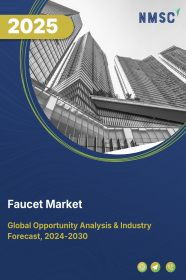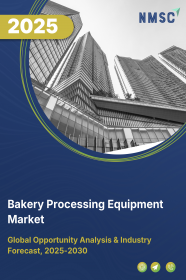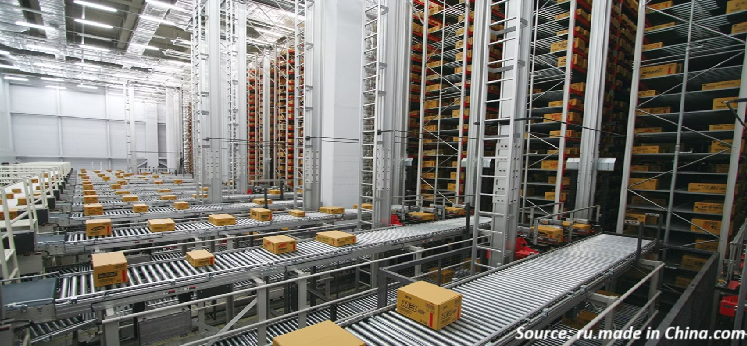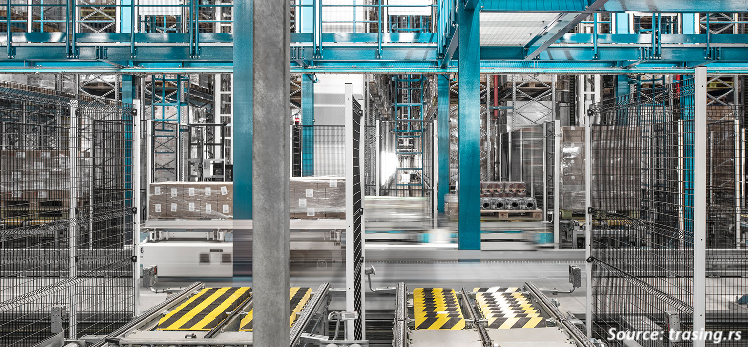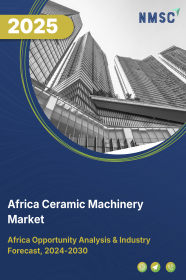
Africa Ceramic Machinery Market by Type (Shaping Machines, Decorative and Glazing Machines, Kilns and Firing Machines, Raw Material Processing Machines, Storage and Handling Machines, and Others Machinery), by Product Type (Tile, Sanitary Ware, Tableware, Technical Ceramics, Refractories, and Abrasive), and by End User (Construction, Automotive, Electronics, and Others) – Global Opportunity Analysis and Industry Forecast, 2024–2030
Industry: Construction & Manufacturing | Publish Date: 23-Dec-2024 | No of Pages: 112 | No. of Tables: 79 | No. of Figures: 44 | Format: PDF | Report Code : CM2788
Africa Ceramic Machinery Market Overview
The Africa Ceramic Machinery Market size was valued at USD 46.6 million in 2023, and is predicted to reach USD 76.6 million by 2030, at a CAGR of 6.9% from 2024 to 2030. The ceramic machinery sector, also known as the ceramic manufacturing equipment sector, involves the global industry that designs, produces, and distributes machinery for making ceramic products such as tiles, sanitary ware, tableware, and advanced ceramics.
This market includes equipment like crushers, grinding mills, kilns, dryers, and presses, used throughout the ceramic production process, from raw material preparation to the final product. Ceramic manufacturing equipment offers high precision for shaping, glazing, and producing ceramics, resulting in consistent product quality, faster production, and lower labor costs. It is essential for meeting the growing need for quality ceramics, supported by advancements in manufacturing technology and increased automation investments.
Increased Tile Production Drives Demand for Advanced Ceramic Machinery
The rise in ceramic tile production across Africa necessitates enhanced production capabilities and efficiency among manufacturers to meet the growing ceramic machinery market demand, thereby accelerating growth.
The World Tile Production and Consumption report indicates that tile production in Africa increased by 13.0%, reaching 1,037 million square meters in 2022. Consumption is also projected to rise by 5.4%, reaching 1,242 million square meters, fueled by increased local production in countries such as Egypt, Algeria, Ghana, Kenya, and Zambia.
This surge in ceramic tiles production volume accelerates the need for advanced machinery to ensure high-quality output, consistent performance, and the capability to handle larger production scales.
As a result, the adoption of sophisticated ceramic machinery enhances precision, speed, and scalability, enabling manufacturers to keep up with the Africa ceramic machinery market expansion and maintain competitive standards.
Ceramic Exports Fuel Demand for Advanced Machinery for Ceramic Manufacturing
The increase in ceramic product exports from South Africa further drives the need for advanced ceramic machinery to boost production efficiency and meet international standards. According to the latest World Integrated Trade Solutions report, South Africa exported 2,744,560 kg of ceramic tableware, kitchenware, and other household items, with a total trade value of USD 9,444.68 thousand.
This heightened export demand accelerates investments in kiln machinery for ceramics, facilitating the production of diverse and sophisticated ceramic products. Consequently, the growth in exports propels the need for cutting-edge technology and machinery to support increased production volumes, thereby contributing to the Africa ceramic machinery market growth.
High Initial Investment Hindering the Expansion of the Ceramic Machinery Market
A significant challenge for the Africa ceramic machinery market expansion is the high initial investment needed for advanced equipment. This substantial financial requirement creates a major barrier, particularly for smaller companies and startups, hindering their ability to invest in the latest technologies.
The large capital needed to purchase and install sophisticated machinery limits these businesses from upgrading their operations or expanding their capabilities. As a result, this financial constraint impedes overall industry growth by restricting many manufacturers from adopting new, more efficient production technologies that could advance the industry.
Integration of Inkjet Technology in Ceramic Machinery Creates Future Opportunities
The integration of inkjet technology into ceramic manufacturing equipment offers a valuable opportunity for the Africa ceramic machinery market growth. This technology allows for high-resolution, customizable printing directly on ceramic surfaces, creating intricate designs, vibrant colors, and detailed patterns. It meets the increasing demand for personalized and aesthetically appealing ceramics.
Additionally, inkjet technology improves production efficiency by reducing reliance on traditional, labor-intensive methods, thus lowering costs and enhancing manufacturing processes. This advancement not only provides a competitive edge but also opens up new growth opportunities within the Africa ceramic machinery market trends, making it a key investment for future development and innovation.
Competitive Landscape
Several market players operating in the Africa ceramic machinery industry include SITI B&T Group S.p.A., Mectiles Italia S.R.L., Breton S.p.A., Air Power Group S.p.A., HANDLE GmbH, Maschinen und Anlagenbau, KERAjet S.A., LB Technology, SACMI, KEDA Machinery, and others.
Africa Ceramic Machinery Market Key Segments
By Type
-
Shaping Machines
-
Decorative and Glazing Machines
-
Kilns and Firing Machines
-
Raw Material Processing Machines
-
Storage and Handling Machines
-
Others Machinery
By Product Type
-
Tile
-
Sanitary Ware
-
Tableware
-
Technical Ceramics
-
Refractories
-
Abrasive
By End User
-
Construction
-
Automotive
-
Electronics
-
Others
Key Players
-
SITI B&T Group S.p.A.
-
Mectiles Italia S.R.L.
-
Breton S.p.A.
-
Air Power Group S.p.A.
-
HANDLE GmbH
-
Maschinen und Anlagenbau
-
KERAjet S.A.
-
LB Technology
-
SACMI
-
KEDA Machinery
REPORT SCOPE AND SEGMENTATION:
|
Parameters |
Details |
|
Market Size in 2023 |
USD 46.6 Million |
|
Revenue Forecast in 2030 |
USD 76.6 Million |
|
Growth Rate |
CAGR of 6.9% from 2024 to 2030 |
|
Analysis Period |
2023–2030 |
|
Base Year Considered |
2023 |
|
Forecast Period |
2024–2030 |
|
Market Size Estimation |
Million (USD) |
|
Growth Factors |
|
|
Companies Profiled |
10 |
|
Market Share |
Available for 10 companies |
|
Customization Scope |
Free customization (equivalent up to 80 working hours of analysts) after purchase. Addition or alteration to country, regional, and segment scope. |
|
Pricing and Purchase Options |
Avail customized purchase options to meet your exact research needs. |

















 Speak to Our Analyst
Speak to Our Analyst



